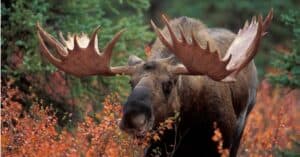The North Pole is located in the middle of the Arctic Ocean and is permanently covered with shifting sea ice. While no animals spend their whole lives precisely at the North Pole (at least not animals known to humans), some species inhabit the nearby waters. These animals sometimes reach the North Pole, too, but scientists aren’t sure they stay there.
Besides the species we’ll list below, it’s essential to mention that other birds, like snow bunting and black-legged kittiwake, have been spotted at or around the North Pole. Moreover, unidentified shrimps and amphipods have been discovered at the North Pole by a Russian team. Other than that, no other discoveries indicate that other living animal species would deliberately choose to live at the North Pole.
So, let’s find out more about those animals that are brave enough to inhabit the Arctic Ocean and even reach the North Pole!
1. Arctic Fox

Arctic foxes get cold only when the temperatures drop to -94 degrees Fahrenheit.
©outdoorsman/Shutterstock.com
| Arctic Fox | |
|---|---|
| Scientific name | Vulpes lagopus |
| Other common names | Snow fox, white fox, polar fox |
| Native to | Northern Hemisphere’s Arctic regions |
| Unique feature | Thick white fur; a large and fluffy tail; pads covered in fur |
| Conservation status | Least Concern |
Arctic foxes are among the few animals that have adapted to harsh and cold environments. These animals get cold only when the temperatures drop to -94 degrees Fahrenheit! They curl up to maintain their body temperature and prevent heat loss by tucking their legs and heads under their bodies and covering them with their fluffy tails! They have thick furs that help them survive low temperatures by providing perfect insulation.
Male Arctic foxes have a head-and-body length of around 22 inches, although some can reach 27 inches. Females are slightly smaller, measuring, on average, 20 inches long. Their tails add roughly 12 inches to their body length. Despite being pretty small, Arctic foxes can reach weights of up to 20 pounds, especially in the autumn, when they tend to increase their body weight by approximately 50% to have better insulation when the weather gets harsher.
2. Northern Fulmar
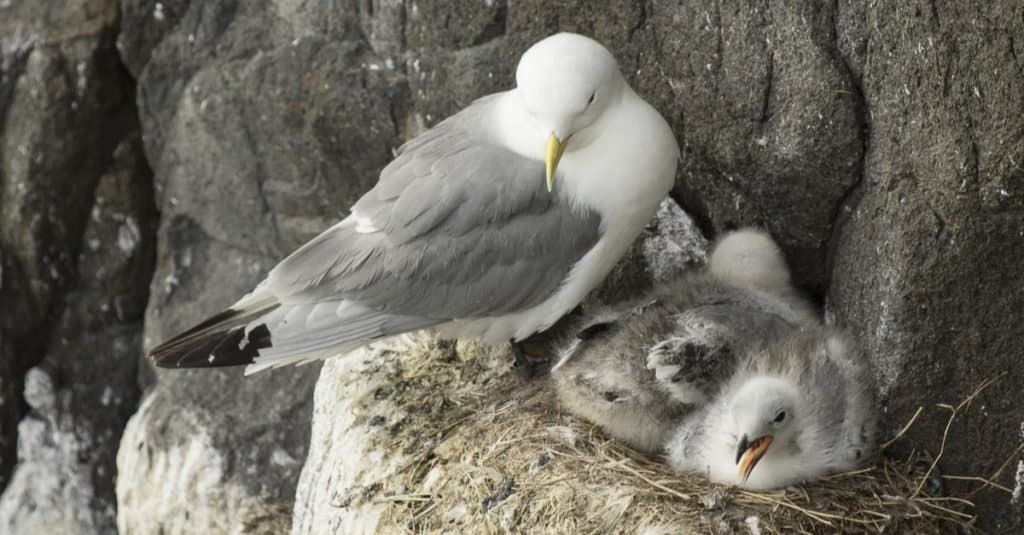
Northern fulmars eat shrimp, squid, fish, plankton, carrion, and jellyfish.
©MichaelY/Shutterstock.com
| Northern Fulmar | |
|---|---|
| Scientific name | Fulmarus glacialis |
| Other common names | Fulmar, Arctic fulmar |
| Native to | Subarctic waters |
| Unique feature | has naricorns and a salt gland above the nasal passage that helps desalinate the body |
| Conservation status | Least Concern |
There are three northern fulmar subspecies:
- Fulmarus glacialis glacialis
- Fulmarus glacialis auduboni
- Fulmarus glacialis rodgersii
Northern fulmars have a wingspan of 40 to 44 inches and a body length of about 18 inches. They have gray and white plumage and bluish legs, and the bills are yellow and thick. These birds are largely distributed in the North Atlantic and North Pacific subarctic waters. They have several unique features that distinguish them from other birds:
- The naricorns – nasal passages attached to the upper bill.
- The stomach oil, consisting of triglycerides and wax esters, is stored in the proventriculus, and the birds spray it out of their mouths, defending themselves against predators; the oil also serves as a food source rich in energy during long flights.
- The salt gland above the nasal passage is designed to desalinate their bodies since northern fulmars spend much time in subarctic waters.
Northern fulmars eat shrimp, squid, fish, plankton, carrion, and jellyfish.
3. Arctic Ringed Seal
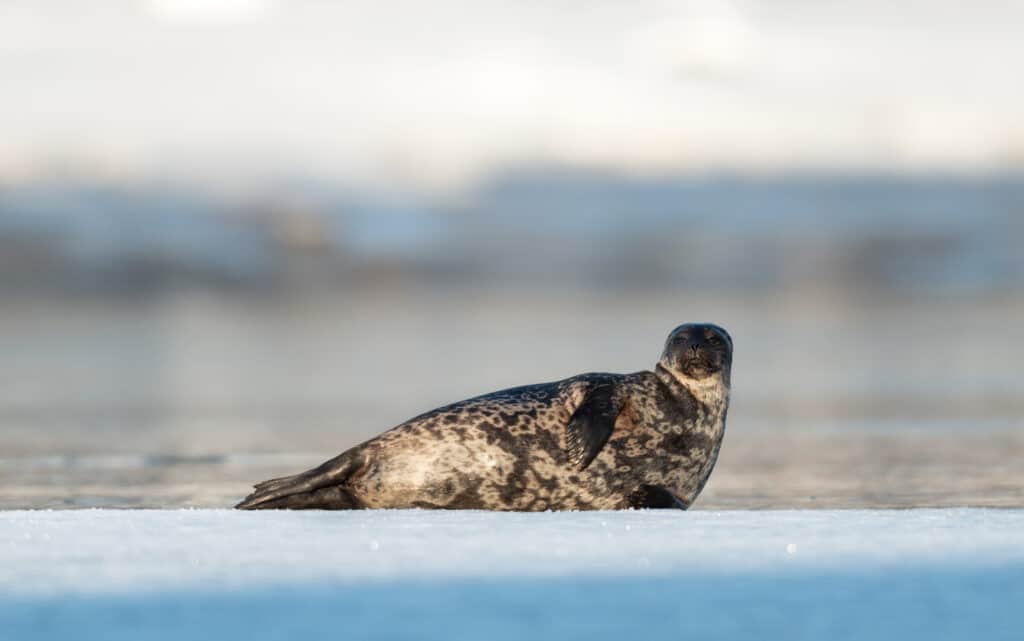
Arctic ringed seals are the most abundant seals in the Northern Hemisphere.
©Sergey Uryadnikov/Shutterstock.com
| Arctic Ringed Seal | |
|---|---|
| Scientific name | Pusa hispida hispida |
| Distribution | The Arctic Ocean |
| Unique feature | Smallest true seal |
| Conservation status | Least Concern |
Arctic ringed seals are the smallest true seals and the most abundant seals in the Northern Hemisphere. While they primarily inhabit the waters around the North Pole, they’ve also been spotted right at the Pole.
These seals can be distinguished by their dark gray fur covered in light spots. Moreover, like other ringed seals, they have strong claws used to pierce ice for breathing holes.
These breathing holes are created when the ice becomes too thick, and they need something to help them breathe. When the weather improves, Arctic ringed seals stay on the ice surface near the breathing holes they’ve created.
Arctic ringed seals feed on Arctic cod, redfish, herring, snailfish, Atlantic salmon, and sand lance. They’re also at risk of becoming prey to polar bears. Arctic foxes are a great threat to Arctic ringed seal pups.
4. Polar Bear

Polar bears are the world’s largest extant bears.
©Vaclav Sebek/Shutterstock.com
| Polar Bear | |
|---|---|
| Scientific name | Ursus maritimus |
| Native to | The Arctic Circle |
| Unique feature | Largest extant bear species and land carnivore; not territorial |
| Conservation status | Vulnerable |
Polar bears are the world’s largest extant bears! They spend most of their lives on sea ice; their scientific name is Ursus maritimus. Moreover, they’re considered the only marine mammals with powerful feet that make it possible for them to run on land. They are also excellent swimmers. One polar bear has traveled nine days without stopping in the Bering Sea!
Adult males are called boars and can weigh up to 1,540 pounds and have a body length of up to 9 feet 10 inches. Conversely, females rarely weigh more than 550 pounds and can only reach 7 feet 10 inches in length. The 4-inch-thick layer of adipose tissue, hide, and fur provides high resistance to cold temperatures. The fur, in turn, has an underlayer of dense fur and an outer layer of guard hairs.
Although resistant to cold temperatures, polar bears rarely go beyond 82° North because there’s no prey in the area. However, during a 2006 expedition to the North Pole, a polar bear was supposedly sighted just a mile from the North Pole.
5. Walrus
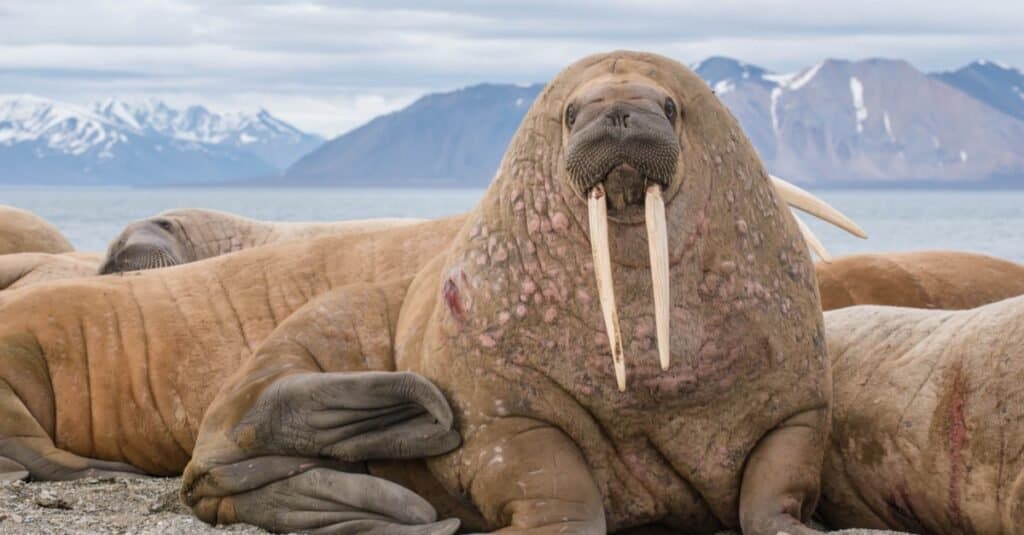
Walruses primarily inhabit shallow waters and prefer staying on the sea ice.
©Mikhail Cheremkin/Shutterstock.com
| Walrus | |
|---|---|
| Scientific name | Odobenus rosmarus |
| Distribution | The North Pole |
| Unique feature | Prominent tusks and whiskers |
| Conservation status | Vulnerable |
Walruses are widely distributed in the Arctic Ocean and the subarctic seas in the Northern Hemisphere. They primarily inhabit shallow waters and prefer staying on the sea ice. A study on Pacific walruses shows that they inhabit the north-central and southeastern Bering Sea during winter. They live along the ice edge in the northwestern and northeastern Chuckchi Sea when the weather improves.
Walruses have a very distinctive appearance thanks to their prominent tusks and whiskers. Males have longer and thicker tusks and often use them for fighting and displaying dominance. They are very large mammals, with males weighing up to 4,400 pounds! That’s thrice as much as the largest polar bear’s weight!
These mammals have thick skin that is sparsely covered with fur, which helps them survive harsh temperatures. When above the water, walruses have brownish skin. When they swim, however, their skin turns white because the cold water causes skin blood vessels to contract.
6. Bowhead Whale
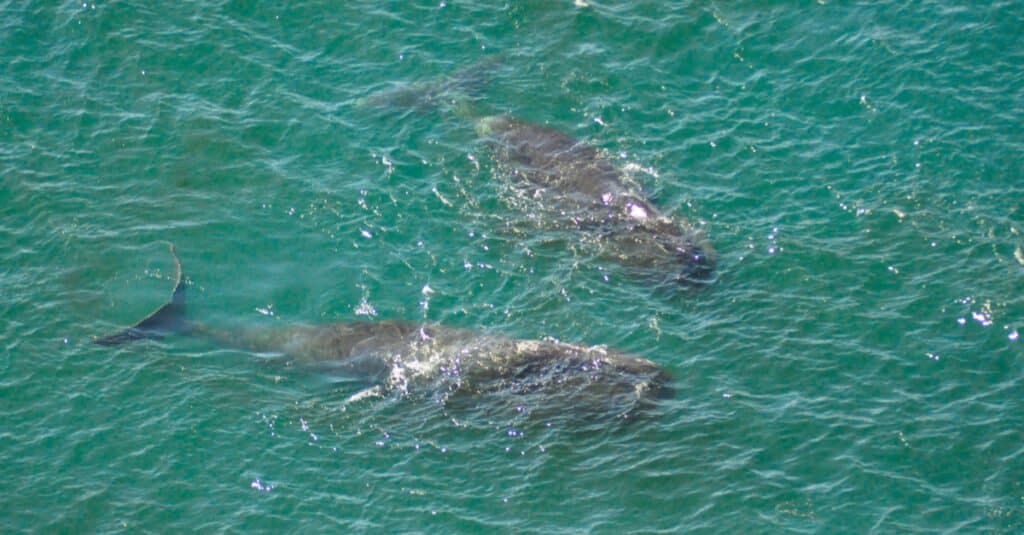
Bowhead whales are solitary animals that travel alone or in groups of up to six whales.
©Vladimir Chebanov/Shutterstock.com
| Bowhead Whale | |
|---|---|
| Scientific name | Balaena mysticetus |
| Other common names | Greenland right whale, Arctic whale, steeple-top, Russian whale, polar whale |
| Native to | The Arctic and subarctic waters |
| Unique feature | Massive triangular skull; has the largest mouth among animals |
| Conservation status | Least Concern |
Bowhead whales get their name from their massive triangular skull. They use it to break through the ice. Moreover, they have the largest animal mouth on Earth! Their mouths represent roughly one-third of their bodies’ length!
They have large, dark bodies with white chins. Their blubber, the thick layer of vascularized adipose tissue, is the thickest, reaching 19 inches! No wonder these mammals can live up to 200 years in those ice-cold waters! Bowhead whales reportedly can reach lengths of 58 – 80 feet. However, these details haven’t been confirmed yet.
Bowheads are solitary animals that travel alone or in groups of up to six whales. They swim at a speed of 1-3 miles per hour but can reach as much as 6.2 miles per hour if threatened. Bowheads primarily feed on zooplankton and crustaceans, eventually consuming two short tons of food a day! They swim with their mouths open to feed because they are filter feeders.
Up Next:
Thank you for reading! Have some feedback for us? Contact the AZ Animals editorial team.






